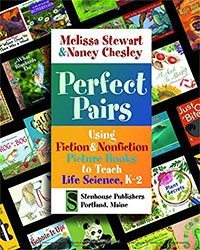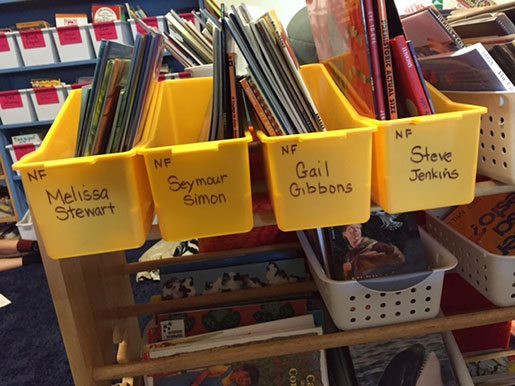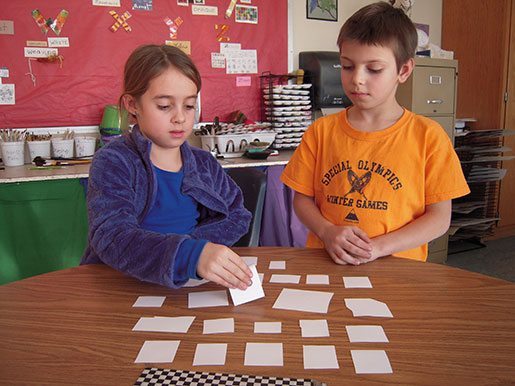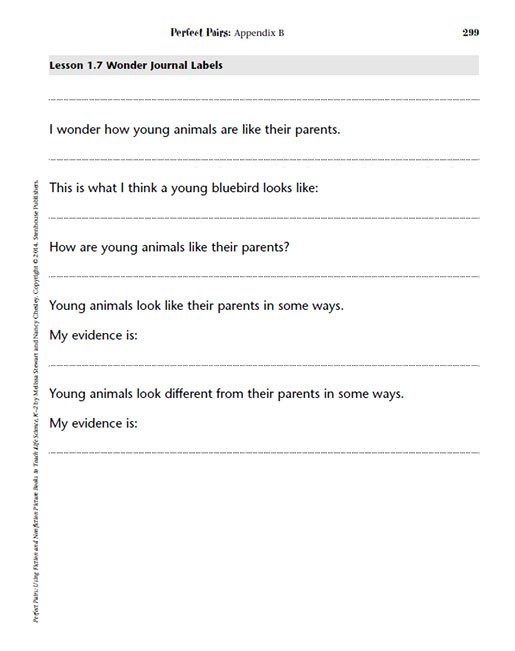Perfect Pairs: Using Fiction and Nonfiction Books to Teach Life Science, K‑2
Melissa Stewart and Nancy Chesley
Stenhouse Books, 2014
Authentic science always begins with a question, with a fleeting thought, with a curious person. That curious person has an idea, wonders if it is valid, and then tries to find out. Because wondering is at the heart of discovery, each Perfect Pairs lesson starts with a Wonder Statement that we’ve carefully crafted to address one Next Generation Science Standards Performance Expectation. It is followed by a Learning Goal, which clearly specifies the new knowledge and essential understanding students will gain from the lesson. Together, the Wonder Statement, Learning Goal, and fiction-nonfiction book pair launch students into a fun and meaningful investigative process. (Perfect Pairs, pg. 8)
 Melissa Stewart, you and educator Nancy Chesley created Perfect Pairs for teachers because you felt that children’s literature could be a fun and effective starting point for teaching life science to students in grades K‑2.
Melissa Stewart, you and educator Nancy Chesley created Perfect Pairs for teachers because you felt that children’s literature could be a fun and effective starting point for teaching life science to students in grades K‑2.
In your introduction, you state that “many elementary teachers do not have a strong science background. Some even report being intimidated by their school’s science curriculum and feel ill-equipped to teach basic science concepts. Building science lessons around children’s books enables many elementary educators to approach science instruction with greater confidence.”
Why does this matter to you?
Because students can tell when their teachers are comfortable and confident, and when they’re having fun. If a teacher has a positive attitude, his or her students are more likely to stay engaged and embrace the content.
So many adults are turned off by or even afraid of science. They say, “Oh, that’s hard. That’s not for me.” But science is just the study of how our wonderful world works. It affects everything we do every day. I hope that Perfect Pairs will help teachers and students to see that.
What type of science education did you receive that propels you to provide this aid to educators?
I do have a degree in biology, but my science education really began at home with my parents. My dad was an engineer and my mom worked in a medical laboratory. From a very young age, they helped me see that science is part of our lives every day.
As a children’s book author, my goal is to share the beauty and wonder of the natural world with young readers. Perfect Pairs is an extension of that mission. Nancy and I have created a resource to help teachers bring that message to their students.
For each lesson, where did you start making your choices, with the topic, the fiction book, or the nonfiction book?
We began with the NGSS Performance Expectations, which outline the concepts and skills students are expected to master at each grade level. Each PE has three parts—a disciplinary core idea (the content), a practice (behaviors young scientists should engage in, such as asking questions, developing models, planning and carrying out investigations, constructing explanations, etc.), and a cross-cutting concept (pattern, cause and effect, structure and function, etc.) that bridges all areas of science and engineering. Here’s a sample PE for kindergarten: “Use observations to describe [practice] patterns [crosscutting concept] of what plants and animals (including humans) need to survive. [DCI]”
 Next, we searched for fiction and nonfiction books that could be used to help students gain an understanding of the target PE. The books became the heart of a carefully scaffolded lesson that fully addressed the PE.
Next, we searched for fiction and nonfiction books that could be used to help students gain an understanding of the target PE. The books became the heart of a carefully scaffolded lesson that fully addressed the PE.
In Lesson 1.7, “How Young Animals Are Like Their Parents,” you paired Toni Buzzeo’s fiction title Just Like My Papa with Pamela F. Kirby’s nonfiction title, What Bluebirds Do. For this lesson, the Wonder Statement is “I wonder how young animals are like their parents.” Your lesson focuses on Inheritance of Traits and Variation of Traits, looking at similarities and differences.
With each lesson, you provide tips for lesson preparation, engaging students, exploring with students, and encouraging students to draw conclusions. What process is this establishing for teachers?
We hope that our three-step investigative process (engaging students, exploring with students, and encouraging students to draw conclusions) is something that teachers will internalize and adopt as they develop more science lessons in the future. The first step focuses on whetting students’ appetites with a fun activity or game. During the second step, teachers read the books aloud and work with students to extract and organize key content from the fiction and nonfiction texts. Then, during the final step, students synthesize the information from the books and do a fun minds-on activity that involves the NGSS practice associated with the PE. The practices are important because research shows that children learn better when they actually “do” science.

In many cases, you’ve not only provided questions that teachers can ask their students, but you’ve included the answers. Is this the only possible answer to the question?
In many cases, we’ve included answers to help the teacher learn the science before working with his or her class. Many elementary teachers have a limited science background and need the support we’ve provided.
Our answers may not be the only ones that students suggest, but they are the ones teachers should guide their class to consider because they develop student thinking in the right direction for the concepts we are targeting in that particular lesson.

I appreciate the photos and examples and kids’ drawings you’ve included throughout the book. How did you go about collecting these visuals?
Nancy tested all the lessons in the book at Pownal Elementary School in Maine. She took the photographs as she was working with the students, and the student work in the book was created by those children. I love the photos because you can tell that the children are really enjoying themselves.

You provide more than 70 reproducibles to accompany the lessons in your book, from Wonder Journal Labels to Readers’ Theater Script to sample Data Tables to drawing templates. How did you decide which items to provide to teachers using your book?
Writing can be a challenge for K-2 students. We created the Wonder Journal Labels to minimize the amount of writing the children would have to do. The goal of the other reproducibles was to help teachers as much as possible and reduce their prep time. It was important to us to create lessons that were easy and inexpensive to implement.

To Melissa and Nancy, I express my gratitude for thoughtfully preparing this guide, Perfect Pairs, that will make science lessons an approachable part of lesson planning. Thank you!

Great interview with Melissa. We have used Perfect Pairs this year with K‑2 and have had a lot of success. Hope to do more with it next year.